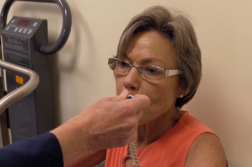ORLANDO, Fla. (Ivanhoe Newswire) — Celiac disease means you have an immune reaction to gluten, a protein found in wheat. It affects about one in 133 Americans. But there’s a lot of misinformation about the condition. We set the record straight.
At least three million Americans are living with celiac disease. But there are a lot of myths about this condition. The first, gluten sensitivity is the same as celiac disease … false. If you have a sensitivity to gluten, you may be able to tolerate small amounts of it. Celiac is a genetic, autoimmune disease that causes damage to parts of the small intestine when you eat gluten. People with this disease can’t have any gluten. Another myth, celiac disease isn’t serious. In fact, if it’s untreated, celiac can lead to thyroid problems, neurological disorders, osteoporosis, cancer, and more.
Bana Jabri, MD, PhD, Director of Research at the University of Chicago Celiac Disease Center says, “Another surprising association is infertility in women.”
Myth number three, you can outgrow celiac disease. Unfortunately, you’ll have it for life. Another fallacy, a gluten-free diet cures celiac disease. There is no cure, but avoiding gluten can prevent symptoms and complications.
“Going on a gluten-free diet is important and that even if you don’t have symptoms when you eat gluten, gluten can actually do a lot of harm,” Dr. Jabri shared.
And one last myth, you’ll have to eliminate all grains if you have celiac disease. Some like quinoa, amaranth, millet, and buckwheat don’t contain gluten and are ok. Separating fact from fiction when it comes to celiac disease.
Doctors believe about 83 percent of Americans who have celiac disease are undiagnosed or misdiagnosed with other conditions.
Contributors to this news report include: Julie Marks, Producer; Roque Correa, Editor.
Free weekly e-mail on Medical Breakthroughs from Ivanhoe. To sign up: http://www.ivanhoe.com/ftk
CELIAC DISEASE MYTHS
REPORT #2505
BACKGROUND: 1 out of every 133 Americans has celiac disease. Celiac disease is an inherited autoimmune disorder that affects the digestive process of the small intestine. When a person who has celiac disease consumes gluten, a protein found in wheat, rye and barley, the individual’s immune system responds by attacking the small intestine and inhibiting the absorption of important nutrients into the body. Celiac disease has over 300 known symptoms, although some people experience none. About 30 percent of the U.S. population is estimated to have the genes necessary for celiac disease. This disease affects more people in the U.S. than Crohn’s disease, cystic fibrosis, multiple sclerosis and Parkinson’s disease combined. People with celiac disease dine out 80 percent less than they used to before diagnosis and believe less than 10 percent of eating establishments have a ‘very good’ or ‘good’ understanding of gluten free diets. It takes an average of 11 years for patients to be properly diagnosed with celiac disease even though a simple blood test exists. There are currently no drugs available to treat celiac disease.
(Source: https://www.cureceliacdisease.org/wp-content/uploads/341_CDCFactSheets8_FactsFigures.pdf and http://celiac-disease.com/facts-statistics-about-celiac-disease/)
SYMPTOMS AND TREATMENT: There seems to be a genetic predisposition to developing celiac disease, however not all people with a family history of celiac disease develop the condition. There is another reason, yet unknown, why the autoimmune response occurs. In addition to family history, celiac disease seems to be more common in people with type 1 diabetes, microscopic colitis, Sjögren’s syndrome and autoimmune thyroid disease. Diarrhea and weight loss, because of malabsorption, are the classic symptoms of celiac disease. However, they occur in less than one-half of people with the disease. The symptoms vary widely in presentation and intensity. Often the symptoms are not related to the bowel function, but instead are due to the consequences of chronic malabsorption of vitamins and minerals. Other symptoms are headache, fatigue and weakness, joint pain, numbness and tingling of the hands and feet, skin rash, abdominal pain, and GERD and heartburn. The only treatment for celiac disease and the inflammation of the small intestine caused by gluten protein exposure is a life-long gluten free diet.
(Source: https://www.medicinenet.com/celiac_disease_gluten_enteropathy/article.htm)
ANOREXIA AND CELIAC DISEASE: A new study suggests young women with celiac disease may face a heightened risk of being diagnosed with anorexia. Swedish researchers found the increased risk for these women was present both before and after their celiac diagnosis. Some U.S. doctors say they aren’t surprised by the findings. “I think a lot of us are aware there is a possibility of celiac patients developing an eating disorder,” said Dr. Hilary Jericho, an assistant professor of pediatrics at the University of Chicago’s School of Medicine. Jericho explained that because the disease requires careful attention to diet, some patients may end up taking those eating restrictions too far. While celiac is far different from an eating disorder, it has certain symptoms in common with anorexia. Both can cause weight loss, fatigue, abdominal bloating and, in children, poor growth and delayed puberty. “Diagnosing anorexia is not always easy,” said Dr. Neville Golden, chief of adolescent medicine at Stanford University School of Medicine. Golden explained that’s why the diagnosis should involve not only a mental health professional, but also a pediatrician or other doctor who can help rule out physical health conditions.
* For More Information, Contact:
Jennifer T. White Jason Fahadi



